
Vector-Borne Diseases


Mosquitoes are the deadliest animals in the world. In 2018, the malaria-carrying Anopheles mosquito alone caused more than 400,000 deaths globally, mostly in children under five. Other mosquito-borne diseases like Zika, chikungunya, and dengue fever, carried by the Aedes mosquito, have been on the rise, with dengue infections increasing 30-fold in last 30 years. Overall, vector-borne diseases account for more than 17 percent of all infectious disease.
More populations are increasingly at risk due to increased urbanization, mosquitoes’ growing resistance to insecticides, and rising temperatures. Abt has worked in nearly 40 countries around the world to deliver the comprehensive suite of solutions required to control the vector-borne threats to public health.
Integrated Vector Control
Working across sub-Saharan Africa, Latin America and the Caribbean, and in Cambodia, Abt has focused on strengthening the capacity of countries to plan and implement safe, cost-effective, and sustainable vector-control interventions, such as indoor residual spraying (IRS), insecticide-treated nets (ITNs), and larviciding.
Indoor Residual Spraying (IRS)
Sub-Saharan Africa is the region of the world most afflicted by malaria. Malaria is more prevalent in sub-Saharan African than any other region of the world. Here, the majority of Anopheles mosquitoes rest on interior walls and typically bite at night. Abt began IRS in sub-Saharan Africa in 2012. IRS is a proven and highly effective malaria-control measure involving the spraying of residual insecticide on the interior walls of homes to kill mosquitoes and interrupt malaria transmission. IRS confers community protection when at least 80 percent of houses in a targeted area are sprayed.
IRS operations are highly complex and require meticulous planning at the national, district, and village levels. Activities range from identifying where spraying needs to occur, to procuring insecticide and equipment, and training thousands of technicians to spray homes and follow environmental and safety guidelines.
Building local capacity to prevent malaria is key. Abt has trained close to 127,000 people in IRS operations, with women representing on average 27 percent of those trained. In 2019 alone, Abt sprayed 5.5 million structures, protecting more than 20 million people from malaria.
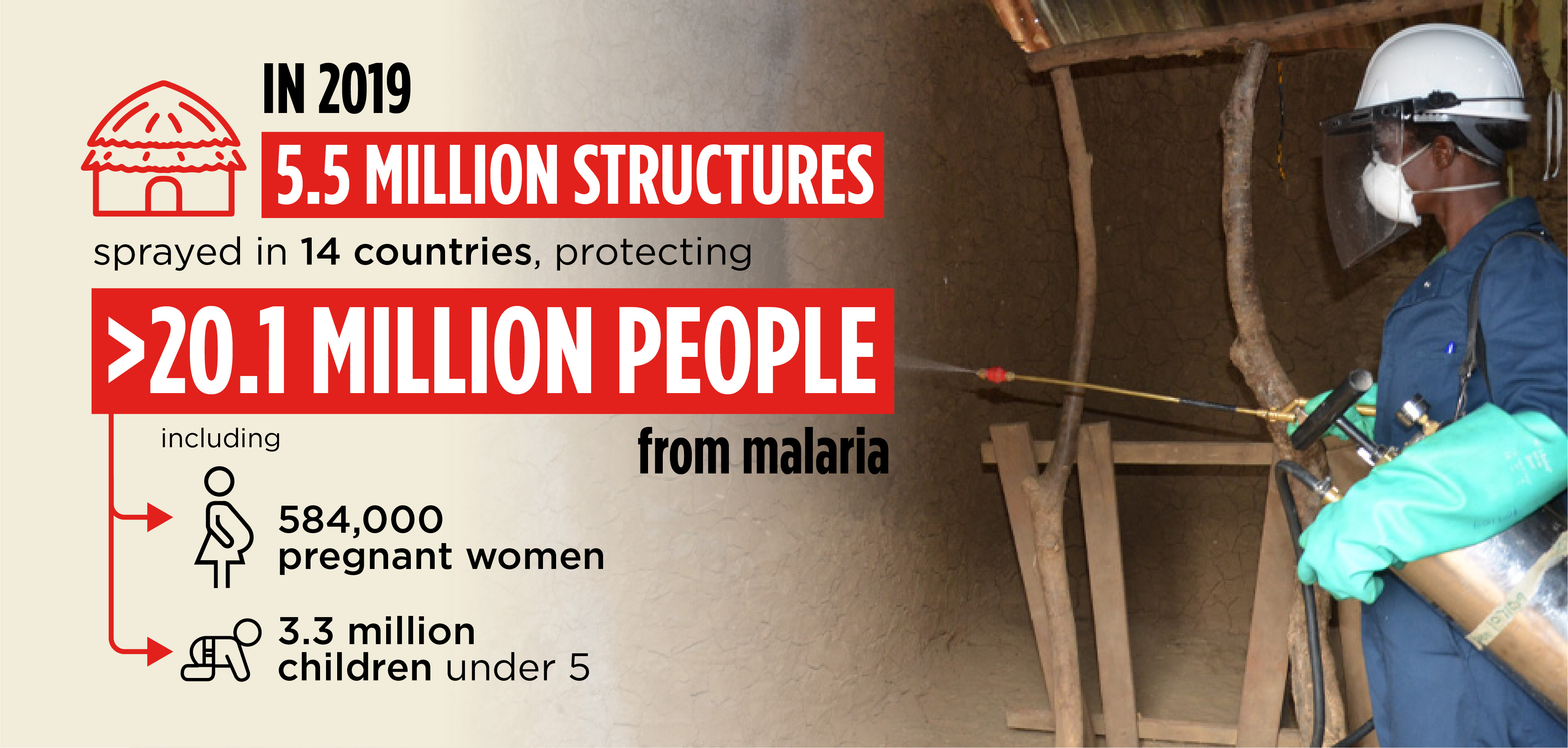
Abt is the largest IRS implementer in the world. Click on the graph and map to explore the number of people we have protected from malaria in Africa across the years.
Project President’s Malaria Initiative (PMI) Africa Indoor Residual Spraying (PMI AIRS) and PMI VectorLink Project
Funder U.S. Agency for International Development (USAID)
Insecticide-Treated Nets (ITNs)
ITNs protect people while they are sleeping from night-biting mosquitoes and have been proven to reduce malaria illness, severe disease, and death in malaria-endemic areas.
In more than a dozen countries, Abt and partners work to monitor the durability of ITNs and help national malaria control programs to plan and execute all phases of distribution campaigns. This includes ensuring that the most vulnerable groups, such as pregnant women and young children, have continuous access to nets. In 2019, Abt and partners strengthened ITN mass or continuous distribution in seven high-malaria burden African countries, including Cameroon, Ghana, Malawi, Niger, Senegal, Tanzania, and Zambia. To date, under the Abt-led PMI VectorLink Project, Abt and partners have distributed more than 8.35 million ITNs.
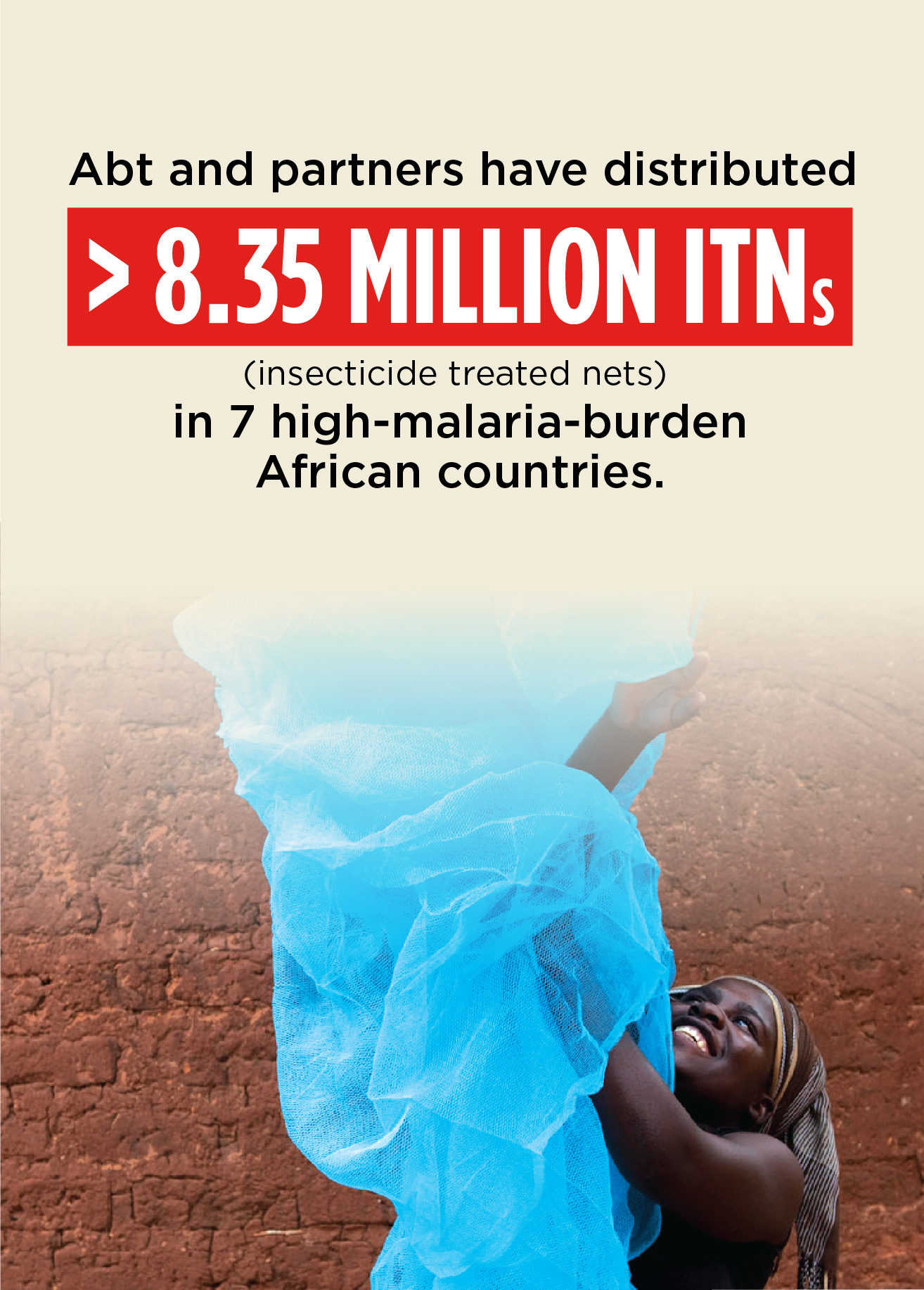
Project President’s Malaria Initiative (PMI) VectorLink
Funder U.S. Agency for International Development (USAID)
Larviciding and Environmental Management
The Aedes mosquito, which carries diseases such as Zika and dengue fever, exhibits markedly different behavior from its malaria-carrying counterpart. As a result, multi-prong control interventions other than IRS or ITNs require careful targeting.
As Zika spread rapidly across Latin America and the Caribbean in 2016, Abt mobilized partnerships in more than a dozen Latin American and Caribbean countries through the USAID-funded Zika AIRS Project (ZAP) to build capacity in entomological monitoring and surveillance, vector control, and environmental management.
Working in the Dominican Republic, El Salvador, Honduras, Haiti, Jamaica, and Guatemala, Abt visited more than 7.5 million households in areas with the highest incidence of Zika to educate communities on reducing risks and to carry out direct vector-control interventions at household levels. The ZAP teams conducted larviciding with naturally occurring bacteria and environmental management interventions to reduce mosquito breeding sites, protecting millions of people from the disease.
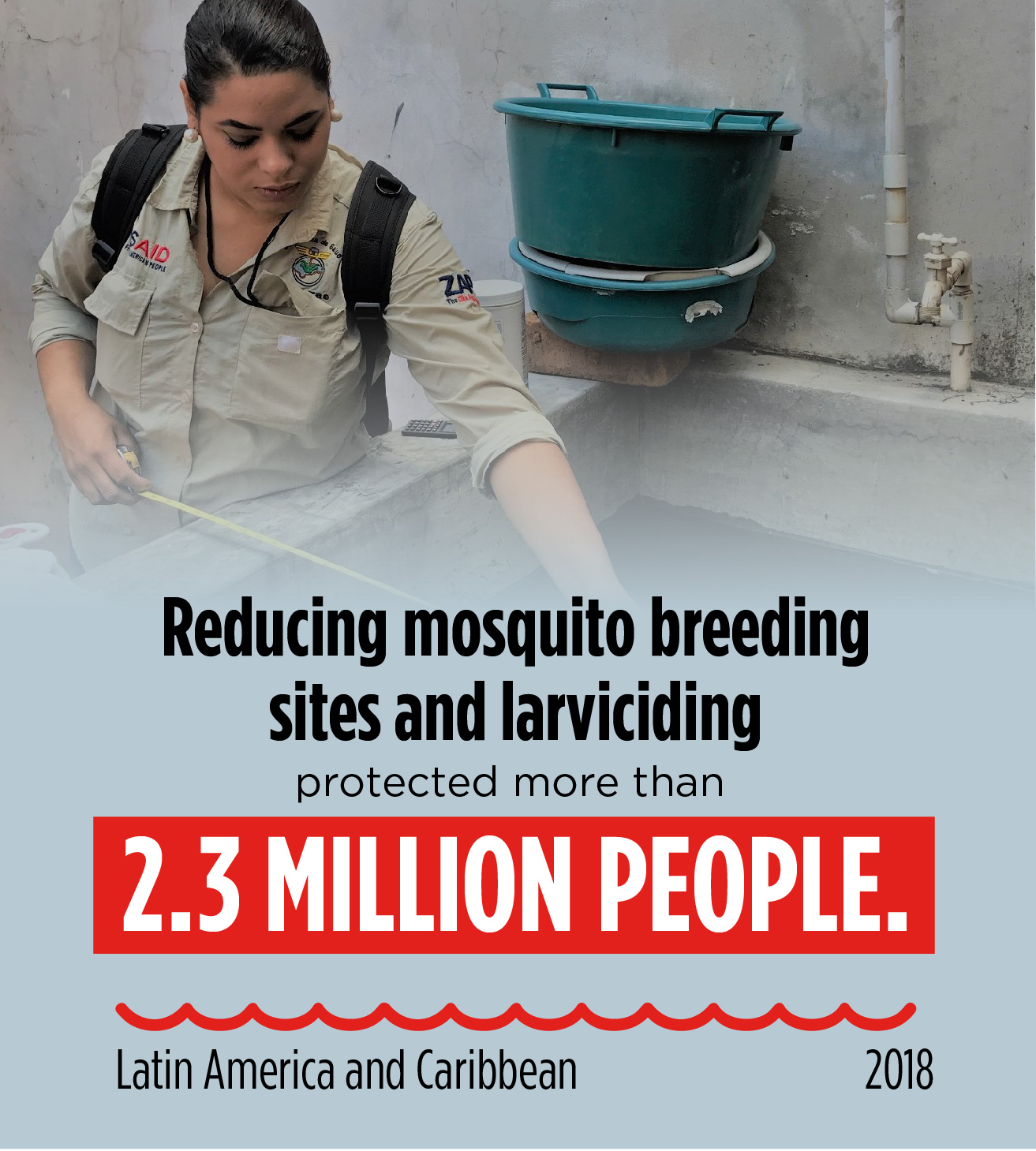
Project Zika AIRS (ZAP)
Funder U.S. Agency for International Development (USAID)

Entomological Surveillance, Monitoring and Capacity Building
Entomological monitoring is a critical component of integrated vector-control programming. Selection and deployment of front-line, vector-control interventions are guided by thousands of data points on incidence of disease, mosquito abundance and behavior, residual life of insecticides, and mosquito resistance to them.
Malaria Entomological Data
Abt currently collects high quality entomological data from 24 countries in sub-Saharan Africa. We systematically analyze, interpret, and present this data as we collaborate with national governments and other malaria-control partners. The goal is to inform selection of insecticides for IRS, selection of effective ITNs, quality and efficacy of IRS, timing of IRS, and replacement interval for ITNs. Evidence-based decisions will enable these interventions to provide maximum protection and reduce malaria transmission.
The insecticide resistance data Abt generates has been instrumental in guiding the transition from a class of insecticides against which the mosquito vector has developed resistance to more effective insecticides for IRS. This information has been effectively used in 14 IRS countries. Nine other countries are now using insecticide resistance data in their selection of ITNs. Abt shares the resistance data we generate with global malaria control communities, as well as the World Health Organization by informing the annual World malaria report.
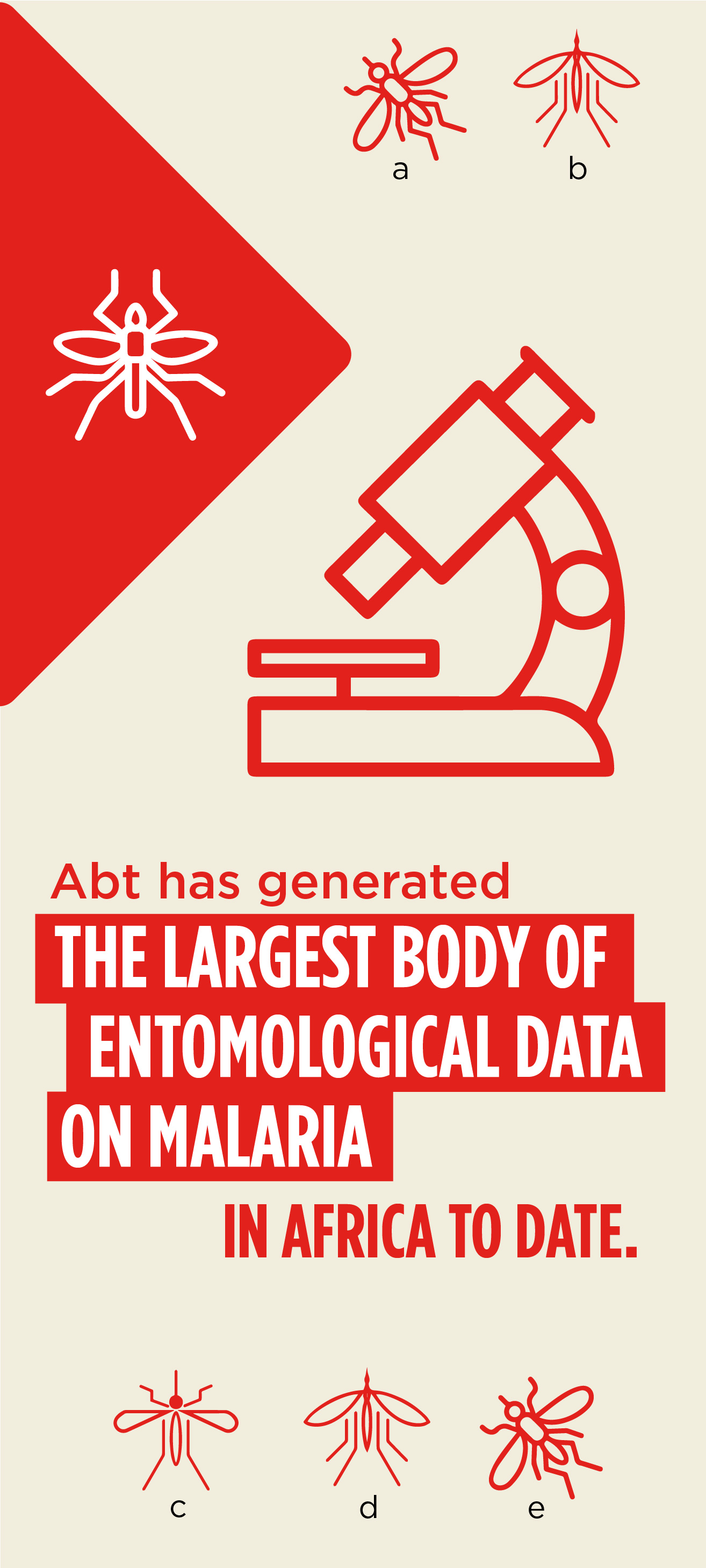
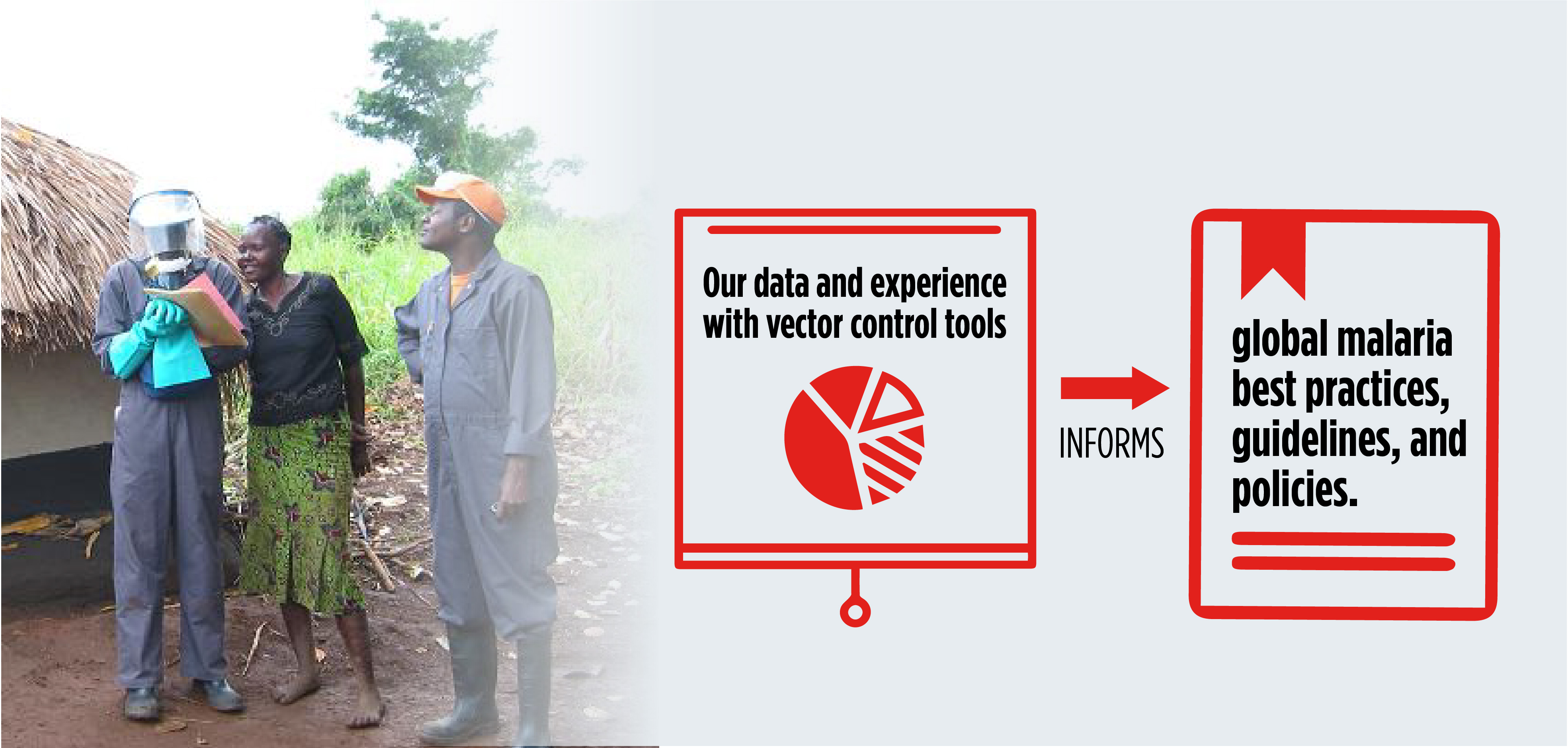
Project President’s Malaria Initiative (PMI) VectorLink
Funder U.S. Agency for International Development (USAID)
Entomological Capacity Building
Trained entomologists are key to establishing a strong monitoring system to combat vector-borne threats. Abt hires trained entomologists to coordinate and lead surveillance and monitoring activities in the countries where we operate. Where local capacity isn’t sufficient, our programs provide extensive training on entomological monitoring, practical demonstrations, and field exercises, and the necessary equipment and supplies to ensure local governments or institutions have the know-how to reduce incidence of the disease.
In response to Zika, Abt focused on building local capacity to conduct state-of-the-art entomological surveillance and vector control across Latin America and the Caribbean, training more than 5,200 vector control and entomology technicians.
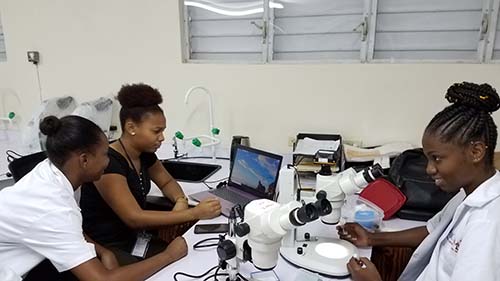
To empower a new generation of entomology specialists, Abt designed diploma programs. These are longer-term, quality training programs that have been institutionalized in partnership with regional and local partners in the Dominican Republic, El Salvador, and Honduras. These countries now have a cadre of specialists with the necessary technical skills and motivation to sustain effective entomology and vector-control programs to protect their countries populations.
Infrastructure for training and cutting-edge research and surveillance is critical. In the fight against Zika between 2016 and 2019, Abt installed and refurbished more than 20 laboratories and insectaries across Latin America and the Caribbean, including insectaries-in-a-box in Guatemala, Haiti, Jamaica, Ecuador, and Barbados. Insectary and lab-strengthening is also ongoing in 24 African countries, with a focus on malaria eradication.
Project Zika AIRS (ZAP), President’s Malaria Initiative (PMI) VectorLink
Funder U.S. Agency for International Development (USAID)
Building Community Awareness
In the midst of the rapidly spreading Zika virus, how did we reach vulnerable populations quickly to share critical prevention and safety information? Our team of health communicators, graphic designers, and public health professionals worked with U.S. Centers for Disease Control and Prevention (CDC) to create a crisis communication campaign comprising of nearly 370 creative pieces in two months. The digital and social networking components of this campaign enabled rapid dissemination of prevention messages and hyper-targeting of audiences. The campaign reached more than 37 million people in the U.S. and Puerto Rico. In November 2017, Abt earned a MarCom Platinum Award for its Zika Prevention Communications Campaign.
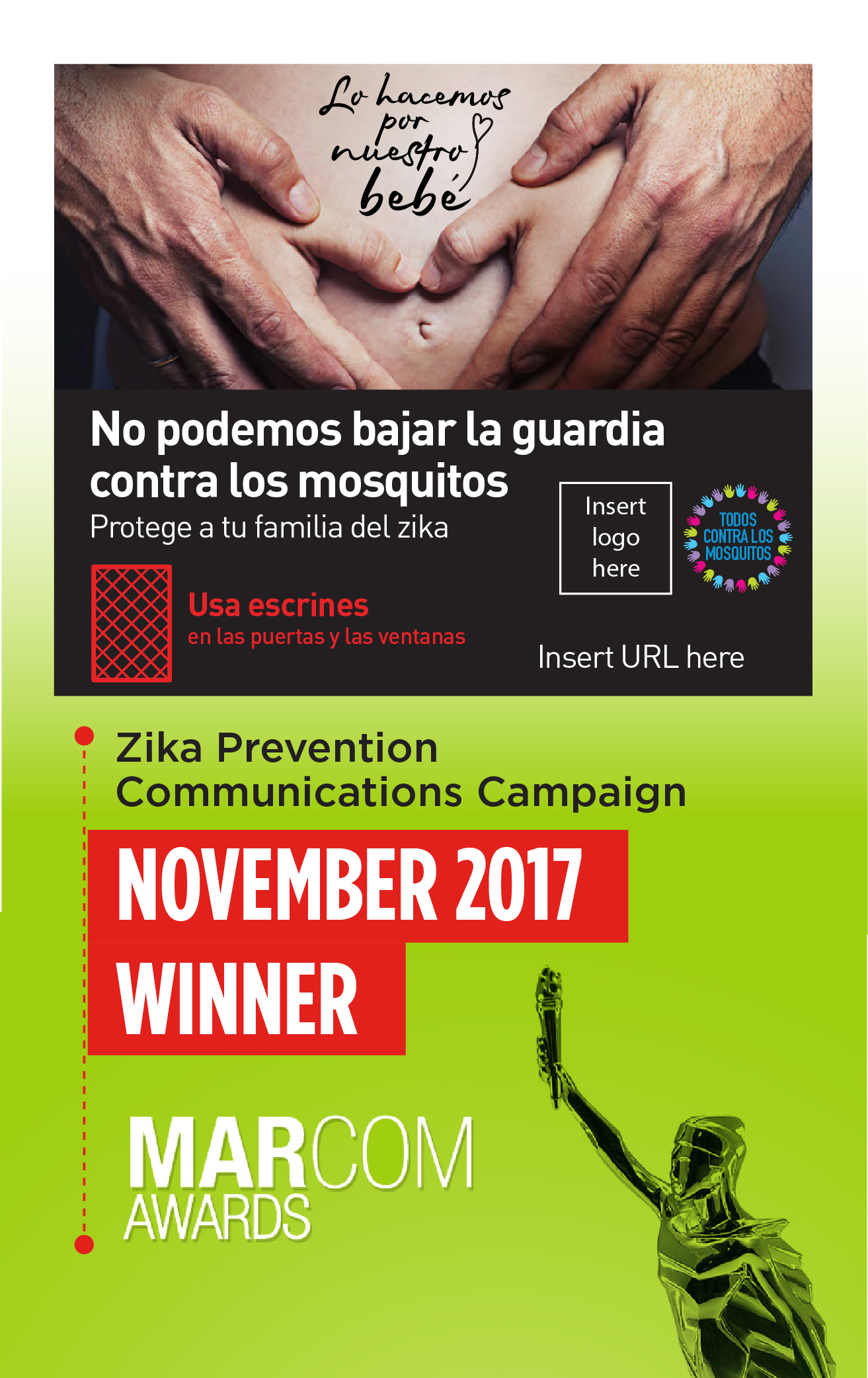
Project Zika Domestic Readiness Initiative
Funder Centers for Disease Control and Prevention (CDC)
IRS saves lives, but only with effective execution of the spray campaigns, and this requires active participation from local communities. The spray process entails significant involvement and participation by targeted beneficiaries, including opening and preparing their homes to spray operators during the actual spray operations. Ensuring a comprehensive understanding and acceptance of IRS activities among target communities is critical.
Abt uses a combination of social behavior change and communication methods to dispel myths, foster community acceptance, and ensure effectiveness of IRS.
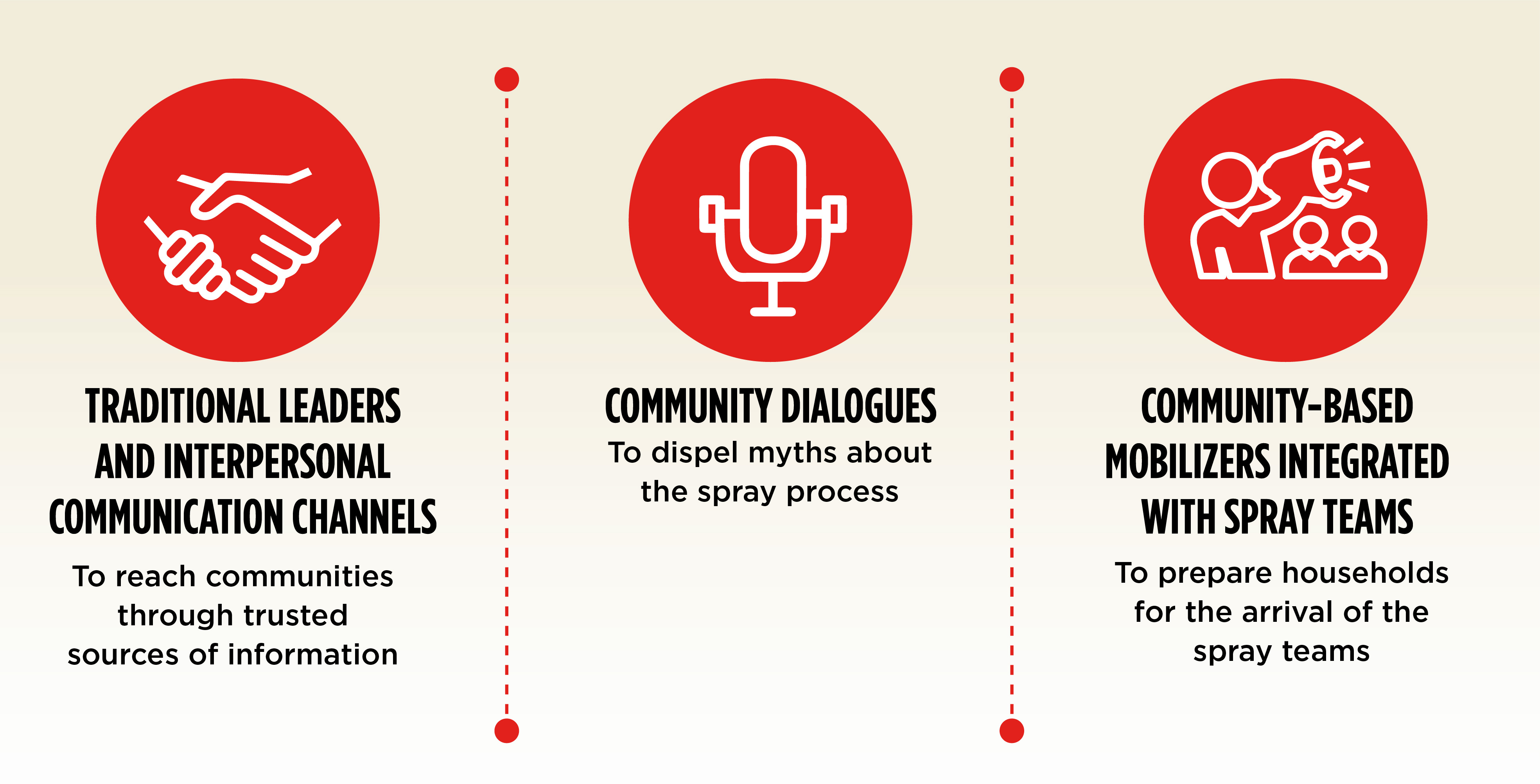
Project President’s Malaria Initiative (PMI) VectorLink
Funder U.S. Agency for International Development (USAID)
Advancing Entomology – from Reimagined Shipping Containers to Computer Vision
“Insectaries in a box” – mini and inexpensive insectaries furnished out of shipping containers –were originally designed by Abt in an effort to continue life-saving entomological monitoring during a military coup in Mali in 2012. Use of these structures has now been scaled up across Africa and Latin America and the Caribbean.

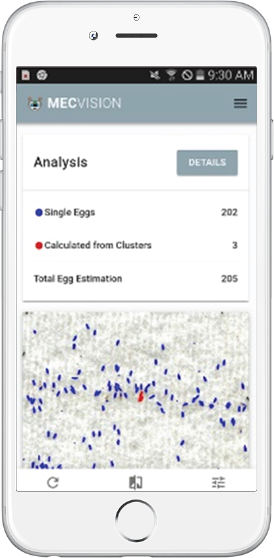
Counting mosquito eggs on paper ovitraps is an important way to gauge prevalence of mosquitoes. Traditionally done by hand, the process is very time consuming, eye-straining, and error-prone. We developed a mobile app using computer vision and AI to help count those tiny eggs the size of ground coffee grains. Our MECVISION app reduces the time it takes to count a sheet-worth of eggs to seconds.
Creating Knowledge to Advance Practice and Inform Investment
Eradicating the vector-borne disease threat will require greater investments in prevention, control, care, and case management, particularly by governments whose countries are most burdened with the disease. Evidence on cost effectiveness of interventions, where resources should be focused, and how expansion of vector control may affect the health system at the facility level are just a few issues that we help inform.
Building the Knowledge Base
In Zambia, our innovative research uncovered that investment in the scale-up of malaria prevention, diagnosis, and treatment programs could free up facility-level resources, such as blood supplies and financial assets, which could be used for treatment of other conditions.
In Senegal, we conducted a cost-effectiveness analysis of five malaria-prevention and treatment-intervention combinations, modelling population-level effects of each option. The analysis enabled Senegal’s National Malaria Control Program to scale up the most cost-effective interventions.
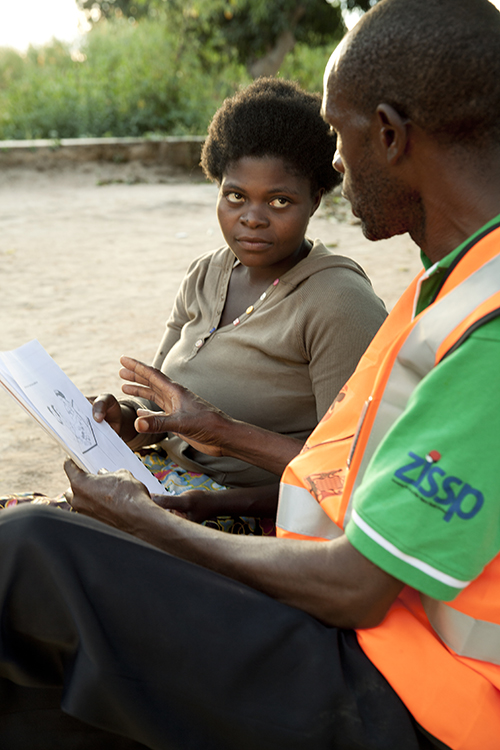
Project Health Finance and Governance (HFG)
Funder U.S. Agency for International Development (USAID)
Improving Care
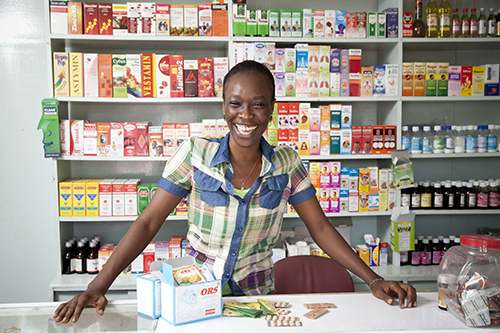
In Ghana, where malaria is the number one cause of morbidity and mortality of children under age five, we increased the availability of National Health Insurance Authority (NHIA)-supported malaria services and medicines in rural areas. The scale up of this insurance coverage, led to a 65.5 percent increase in the likelihood that a caretaker seeks formal medical treatment for a child’s fever or cough, and an almost 72 percent increase in the likelihood of receiving malaria medication.
Aside from children under five, pregnant women have the highest risk of dying from malaria. Timely diagnosis and treatment is critical for this vulnerable population. Working with private providers and community pharmacists, we increased knowledge and acceptance of the use of rapid diagnostic tests (RDT (RDTs) before treating any suspected case of malaria. Over a four-year period (2014–2017), we trained close to 3,000 providers and facilitated distribution of 160,425 RDTs, which significantly increased the rate of malaria detection across the nation.
Project Sustaining Health Outcomes through the Private Sector (SHOPS) Plus, Ghana
Funder U.S. Agency for International Development (USAID)
In Zimbabwe, we trained more than 2,770 health-care workers to ensure pregnant women received early preventive malaria treatment such as intermittent preventive treatment in pregnancy (IPTp) during their antenatal clinical visits. To expand the number of trained providers at the community level and increase early seeking of care for fever—critical to bringing down mortality rates in rural, hard-to-reach populations—we trained 1,598 facility-based health workers and 1,184 village health workers in malaria case management.

Project Zimbabwe Assistance Program in Malaria (ZAPIM)
Funder U.S. Agency for International Development (USAID)
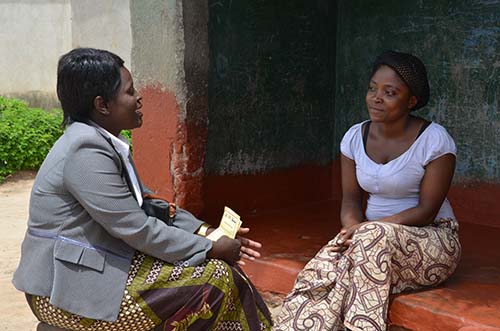
In Zambia, we collaborated with the National Malaria Control Center to update the malaria case management guidelines and trained 1,013 health workers from 77 districts in the diagnosis and treatment of uncomplicated and severe malaria.
Project Zambia Integrated Systems Strengthening Program (ZISSP)
Funder U.S. Agency for International Development (USAID)
